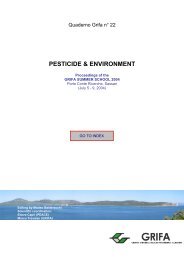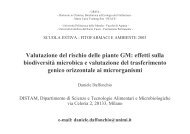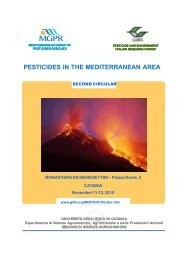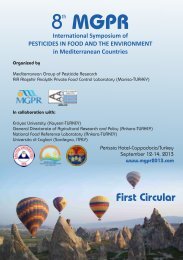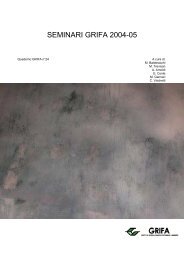International Congress BIOLOGICAL PRODUCTS - Gruppo di ...
International Congress BIOLOGICAL PRODUCTS - Gruppo di ...
International Congress BIOLOGICAL PRODUCTS - Gruppo di ...
You also want an ePaper? Increase the reach of your titles
YUMPU automatically turns print PDFs into web optimized ePapers that Google loves.
PRESENCE OF OCHRATOXIN IN EXPERIMENTAL WINES RELATED TO PESTICIDES<br />
TREATMENTS EMPLOYED ON GRAPES<br />
R. Lo Curto*, F. Vilasi*, T. Pellicanò*, P. Munafò**, G.mo Dugo*,<br />
* Università degli Stu<strong>di</strong> <strong>di</strong> Messina, Dip.to Chimica Organica e Biologica.<br />
** Centro Analisi & Servizi S. r. l. via U. La Malfa, 18 - 98051 Barcellona P. G., Messina, Italia.<br />
Introduction<br />
Mycotoxins are a class of highly toxic chemical compounds produced, under particularly environmental con<strong>di</strong>tions, by<br />
several moulds developing in many foodstuffs. Their presence is depen<strong>di</strong>ng upon several factors such as: fungal strains,<br />
climate and geographical con<strong>di</strong>tions, cultivation techniques and foodstuffs conservation (1). Mycotoxins may occur in<br />
various vegetal products as cereals, dried fruits, coffee beans, cocoa and beverages as beer and wine (2-4). Among<br />
mycotoxins very important are the ochratoxins. This term in<strong>di</strong>cates a group of metabolites, having showing similar<br />
chemical structure, produced by strains of the genus Aspergillus (A. ochraceus) and Penicillium (P. ferrucosum) (1,5,6).<br />
The most stu<strong>di</strong>ed, both for its <strong>di</strong>ffusion and toxicological importance is Ochratoxin A (OTA) R-N-[(5-chloro-3,4<strong>di</strong>hydro-8-hydroxy-3-methyl-1-oxo-1H-2-benzopyran-7-yl)carbonyl]-phenylalanine.<br />
It has an oral DL50 level of 20<br />
mg/kg in rats and pig (7). OTA is highly toxic and causes severe animal and human intoxications, for example “Porcine<br />
nephropathy” and “Balcan Endemic nephropathy” (8-10). OTA exhibits nephrotoxic and teratogen activites and<br />
moreover suppressive actions on immune system, causing a <strong>di</strong>minution of immune globulin level and of other humoral<br />
factors in mice and chicken and a reduction of cell immune response (10,11).<br />
Recently, more attention was focused on Ochratoxin A levels in commonly consumed foods, especially fruits and<br />
cereals (12,13) and in their fermentation products like beer (14-16) and wine (17-25).<br />
As far as wine is concerned, available data regar<strong>di</strong>ng the presence of OTA are very <strong>di</strong>scordant, some Authors reported a<br />
high toxin concentration (up to 7.0 ng\ml) with considerable level of contamination (incidence up to 92%) in red wine<br />
produced in southern regions of Europe and in North Africa. Other Authors reported OTA contamination levels ranging<br />
3.9% for white wines to 16.6% for red wines, even if these data were obtained by <strong>di</strong>fferent analytical methods.<br />
Generally red wines contain a greater amount of OTA than white or rosè ones. These <strong>di</strong>fferences can be attributed to<br />
climatic factors, grape cultivation and storage con<strong>di</strong>tions apart from wine-making techniques. The content of OTA in 23<br />
samples of red and white wine, produced in the year 2000 by three experimental vite, situated in three <strong>di</strong>fferent Italian<br />
regions treated with <strong>di</strong>fferent pesticides see tables 1,2,3), is reported in this work (26).<br />
Materials and methods<br />
Chemicals and Reagents<br />
Standard of OTA, so<strong>di</strong>um chloride, polyethylene glycol (Peg 8000), so<strong>di</strong>um hydrogencarbonate, glacial acetic acid and<br />
toluene were obtained from Fluka (Milano-Italy). Immunoaffinity columns were purchased from Vicam (Waterton,<br />
MA, USA).Acetonitrile, methanol and water (HPLC grade) were supplied from Carlo Erba Reagents (Milano-Italy).<br />
Wine samples<br />
A total of 23 wine samples (16 white 7 red samples), produced in the year 2000 by three experimental vite, situated in<br />
three countries “Avellino”-Campania, “Catania”-Sicily and “Grosseto”-Tuscany, were analysed.<br />
Wine characteristics and pesticide treatments<br />
White wines came from Sicily and Campania in the crop year 2000. Sicilian wines were produced from 15 -20 years old<br />
plants, grown up on Etna (300 m asl, S. Venerina, Catania, Italy), in a vulcanic soil. Vines were grafted with Inzolia and<br />
Carricante varieties in 1:1 ratio. Wines from Campania were produced from 25 years old plants grown up on<br />
Montefredane hills (700 m asl, Avellino, Italy), in a clayey soil. Vines were grafted with Fiano d’Avellino variety. Red<br />
wines from Tuscany were produced from 25 years old plants, cultivated in Maremma Toscana coast (100 m asl,<br />
Grosseto, Italy), on a calcareous soil. Vines were grafted with Sangiovese variety, Morellino clone. Vinification process<br />
was run within 24 hours after grape harvesting and it was run using the following scheme:<br />
White Vinification<br />
Newly – cropped Vitis vinifera grapes from Sicily and Campania were crushed destemmed and then soft pressed by a<br />
pneumatic press. Must was treated with SO2 (30 g/hl), pectolitic enzymes (1.5 g/hl) and vitamin C (5 g/hl) to favour<br />
clarification before fermentation; temperature was maintained at 8°C for 24 hours. Clear must was spiked with 20 g/hl<br />
of thiamine and ammonium phosphate as fermentation coadjuvans and 30 g/hl of selected yeasts and fermentation was<br />
run at 15°C. In order to remove lees, after fermentation wine was decanted into a tank and spiked with SO2 (5 g/hl). Ten<br />
days later wine was decanted again and treated with SO2 (5 g/hl). Wine was finally filtered twice trough 1 µ and 0.45µ<br />
cardboards filters, spiked with SO2 (2-3 g/hl), bottled in dark bottles and maintained at 4°C for the duration of the<br />
experimentation. Each grape sample was separately vinificated, following the above mentioned protocol.<br />
Red vinification<br />
Newly – cropped Vitis vinifera grapes from Tuscany were crushed and destemmed, then spiked with SO2 (5<br />
g/hl), added with selected yeasts (30 g/hl) and let to ferment for 10 days at 28°C, making three fullings a day. Wine was<br />
drawn from the vat and the vinasses pressed by a hydraulic press. After 4 weeks, lees were removed and the wine<br />
PDF creato con FinePrint pdfFactory versione <strong>di</strong>mostrativa http://www.secom.re.it/fineprint<br />
25



